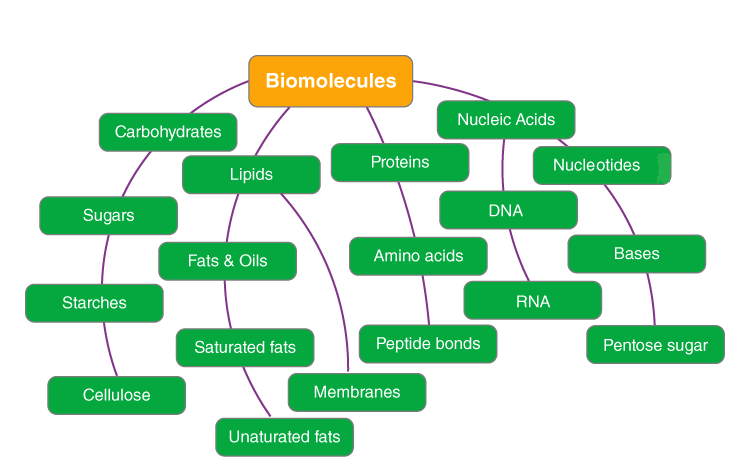Biomolecules in Living Organisms
Living organisms consist of the fundamental unit known as the cell. These cells are composed of a combination of both organic and inorganic compounds. Elemental analysis of cell constituents reveals the presence of carbon, oxygen, hydrogen, nitrogen, phosphorus, among others. Biomolecules such as Proteins, Carbohydrates, Fats, and Nucleic acids constitute the essential components of cells.
What are Biomolecules?
Biomolecules are defined as any organic molecule present in a living cell which includes carbohydrates, proteins, fats etc. Each biomolecule is essential for body functions and manufactured within the body. They can vary in nature, type, and structure where some may be straight chains, some may be cyclic rings or both. Also, they can vary in physical properties such as water solubility and melting points.
Types of Biomolecules
Biomolecules are primarily classified into 4 types, namely:
Carbohydrates
Polysaccharides, commonly known as carbohydrates are macromolecules. They are polymers made up of monosaccharide monomers (sugar molecules). The majority of living cells are rich in carbohydrates and they are the final products of many metabolic processes. For example, Glucose is the final product of photosynthesis. Carbohydrates can be monosaccharides, disaccharides, polysaccharides etc. based on the number of sugar molecules they are made up of.
Detailed Reading: Carbohydrates
Proteins
Proteins are intricate polymers, constructed from monomeric units comprising 20 different amino acids. These amino acids are meticulously linked together in a specific sequence through peptide bonds, forming lengthy polypeptide chains. Amino acids themselves are derivatives of methane, with a central carbon atom bound to an amino group, a carboxylic group, a hydrogen atom, and various distinctive R groups. The R group varies among different amino acids, leading to a diverse array of properties. For instance, Glycine features a simple hydrogen atom as its R group, while Alanine is characterized by a methyl (-CH3) group. Within proteins, there are precisely 20 amino acids, of which 11 are considered non-essential, meaning the body can synthesize them, and 9 are essential, necessitating supplementation through the diet.
More to Read: Proteins
Lipids
Lipids, as hydrophobic macromolecules, encompass a range of compounds such as fats, oils, waxes, phospholipids, and steroids. Fatty acids, the simplest form of lipids, consist of carboxylic acids with a variable R group, which can be saturated or unsaturated. When combined with glycerol, a trihydroxy propane molecule, fatty acids form triglycerides. Phospholipids, a key component of cell membranes, are composed of two hydrophobic fatty acid tails and a hydrophilic head containing a phosphate group.
Further Reading: Lipids
Nucleic Acids
DNA and RNA, the genetic blueprints of all living organisms as well as viruses, are classified as nucleic acids. Nucleic acids are intricate polymers composed of nucleotides. Each nucleotide comprises a nitrogenous base, a sugar molecule (deoxyribose in DNA and ribose in RNA), and a terminal phosphate group. Nitrogenous bases are categorized into two types: pyrimidines and purines. When a base is linked with a sugar, forming a nucleoside, it subsequently combines with a phosphate group to create a nucleotide. These nucleotides are then connected through phosphodiester bonds to create larger nucleic acid molecules like DNA and RNA.
Within the human body, trillions of cells exist, each constructed from a complex interplay of carbohydrates, proteins, and various other biomolecules. These biomolecules serve as the foundational building blocks for cellular structure and function, facilitating the vast array of activities that are vital for life processes.
Biomolecules – Questions
1. What are Biomolecules?
Any organic molecule present in a living cell is called a biomolecule. It typically includes carbohydrates, proteins and fats.
2. What are the 4 types of biomolecules?
Biomolecules can be classified into carbohydrates, proteins, lipids and nucleic acids.
3. What are the nucleic acids?
Nucleic acids are essentially the genetic materials present inside an organism. It is typically in the form of DNA or RNA.
4. What are fatty acids?
Fatty acids are carboxylic acids with a linear long-chain hydrophobic R group.
5. What are proteins?
Proteins are biomolecules made of amino acids joined together by peptide bonds.
An important introductory topic to biochemistry, biomolecules are essential to understanding how biology and chemistry intertwine.

